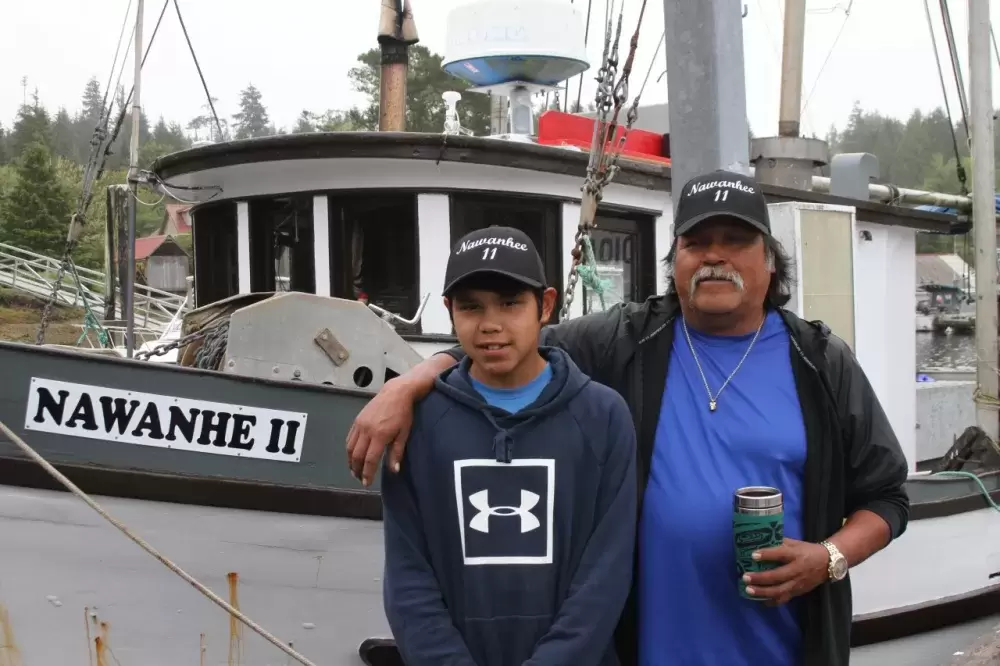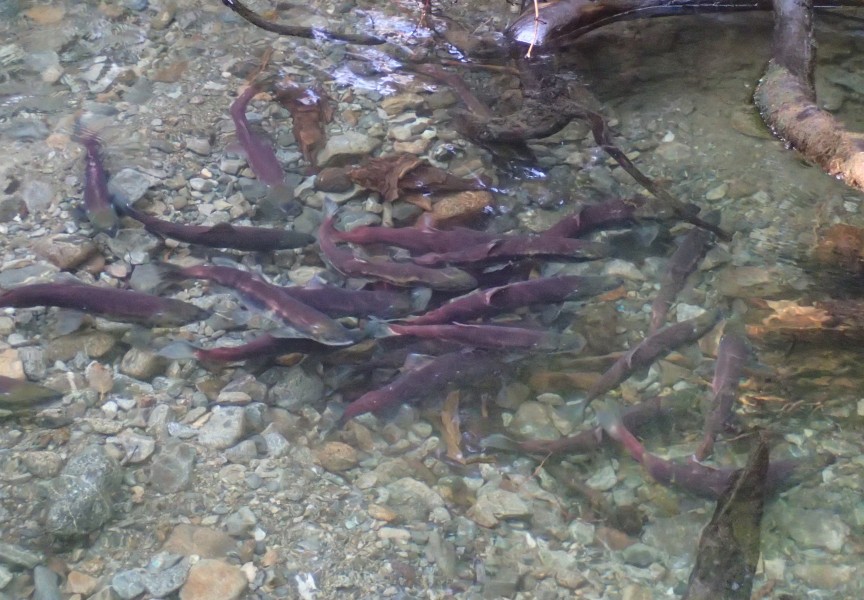At the age of 15, Jayson Nookemus is a fast learner while on the water. For years the teenager has accompanied his grandfather, James Nookemus, learning the details of operating a fishing boat while not in school.
“He learned how to work the gear, clean fish, ice fish, he learned about the electronics in the wheelhouse,” said James, who uses his boat to catch chinook salmon commercially, as well as harvesting fish for the Huu-ay-aht’s food, social and ceremonial purposes when the opportunity arises.
“I just like being on boat with him,” said Jayson of his time with his grandfather.
“My wife says, ‘If you teach him too much too soon, you’ll go down to your boat and your boat is going to be gone one day’,” chuckled James, who from a young age learned to fish from his father, William Clifford Nookemus.
James purchased his boat in 2014 with hopes to create economic opportunity for his family and tribe.
“I was seeing my father missing fishing, seeing him every day at the dock being bored,” said the lifelong fisherman.
But despite Jayson’s eagerness to learn how to operate his grandfather’s fishing boat, it’s unclear how much opportunity his generation will have working on their territorial waters. As an Area G commercial troller, James has seen his quota cut since he bought the boat, with a shrinking period when he can harvest. This year has been particularly tough, with just six and a half fishing days that were permitted in early August. In 2018 Area G trollers saw less than two weeks in openings, and James had to venture to the north side of Nootka Island off Vancouver Island’s west coast.
“This year and last year it never opened for us in the spring in Barkley Sound, we had to go up to Esperanza,” he said.
It’s a drastic change from the profession James grew up in. He recalls a time when the season opened April 15, lasting until the end of September. The Nookemuses fished seven to 24 miles offshore, travelling as far north as Estevan Point at Hesquiaht, or 35 miles south of their home on the southern edge of Barkley Sound.
Ed Johnson Sr. also grew up fishing in the area, but like many First Nations fishermen, he sold his commercial licence in the early 1990s when it was no longer a viable cost. He recalls a time his First Nation was even able to fish inside the surf line in February and March.
“I’ve seen it where we were allowed to fish just about every day,” recalled Johnson. “Before you used to be able to gillnet and troll with one licence.”
While regulations have tightened where and when commercial boats can fish, the number of licences has drastically shrunk since the 1980s. Fisheries and Oceans Canada’s list of licenced commercial vessels in the Pacific has declined from 6,690 in 1985 to 2,372 in 2017, with an estimated 5,000 fishers currently working on the water annually.
Amidst this decline came a recommendation from the Senate Standing Committee on Fisheries and Oceans in 1998 that DFO “more equitably distribute the resource to allow small-scale fishers a better opportunity of participating in the fisheries.”
The drop has been even more severe for the Huu-ay-aht First Nations, with their commercial vessels falling from 40 in the 1980s to the current count of three. Ed Johnson Sr., who sits on the Maa-nulth fisheries committee, believes his nation is feeling the effects of generations of resource mismanagement on the part of Fisheries and Oceans Canada.
“How many times did they fish out the herring? I think they’ve done it three times in my lifetime,” he said. “I really hope they don’t open it up because that’s a big food source for the salmon.”
Herring are one of many factors that could point to the decline of Pacific salmon stocks. This summer DFO released the State of Canadian Pacific Salmon, a report that highlighted the effects of global warming on the fish. The document detailed that chinook are declining throughout their range, as are southern coho, while some sockeye populations in southern B.C. face extinction.
“DFO has to change the way they do things,” said Johnson. “The federal government needs to maybe even get out of it for the fishery to survive.”
With a federal election on the horizon, the Huu-ay-aht First Nations invited Courtney Alberni MP Gord Johns to Bamfield on Aug. 21 to communicate the importance of pursuing a livelihood on their territorial waters. During the meeting several members of the First Nation wore caps with the names of their families’ current or former fishing boats.
“Huu-ay-aht has some very serious and very urgent issues related to fisheries,” stressed Chief Councillor Robert Dennis Sr., noting a discussion he had recently with a commercial fisherman in his nation. “He described it as ‘I’m a step away from being homeless’. That’s sad when you consider where that family was 20 years ago. They were well off, they were making a good living from the fishing industry.”
It’s a difficult state for the nation to face, considering the Huu-ay-aht’s long history of economically benefitting from the ocean’s resources. This was documented by the Spanish in the late 1700s, and in 1874 Hudson’s Bay Company employee George Blenkinsop noted the “abundance of marine resources in Huu-ay-aht territory,” said Dennis. A federal census in 1891 listed 46 Huu-ay-aht members as fishermen or sealers.
“That’s a lot considering the population back then might have been 300 Huu-ay-aht,” he said. “The important part was that our forefathers were boat builders. They didn’t stand idly waiting for handouts or anything. They said we need to build a boat, so we’re going to do it.”
But being entrepreneurial can be daunting in a small coastal community like Bamfield, which used to have four fishing plants. Those closed long ago, and the closest processing facility is on the other side of Barkley Sound in Ucluelet.
“Wealth starts in rural communities, wealth starts in coastal communities, but it leaves coastal communities,” said Gord Johns. “Reconciliation would be prioritizing Indigenous fishers and ensuring that there’s adequate measures to bring our fisheries back to abundancy.”
Now the Huu-ay-aht eagerly await a ruling from the B.C. Court of Appeal on the scope of the Aboriginal right of five Nuu-chah-nulth nations to harvest and sell fish from their territory. In 2009 the Huu-ay-aht decided to step away from the Ahousaht et al vs Canada litigation, after the nation decided that participation in the case was hindering its ability to concluded treaty negotiations with Canada.
But a clause in the Maa-nulth Final Agreement allows the treaty nations, which include Huu-ay-aht, Uchucklesaht, Toquaht, Yuułuʔiłʔatḥ and the Ka:'yu:'k't'h'/Che:k'tles7et'h' First Nations, to benefit from the litigation.
“Maa-nulth nations could negotiate a fishery comparable to the five nations’ agreements with DFO, and then move those licences into the treaty where the fishing licences and rights would be constitutionally protected,” stated a Huu-ay-aht document on the “me too” clause in the treaty.
The hope is that this could empower Huu-ay-aht members to profit from their resources near Bamfield.
“It would be really good if people that came to visit Huu-ay-aht said, ‘…I would like to have a halibut steak that was caught by one of your local fishermen’,” said Dennis. “But instead what we have to do in Huu-ay-aht territory is our restaurant has to order the fish from Nanaimo. So the fish goes, loaded on the dock, goes to the processing plant, goes to the retailer that’s selling it and then it comes back to Huu-ay-aht. For the life of me I can’t understand why James can’t tie his boat down there and sell the fish.”







